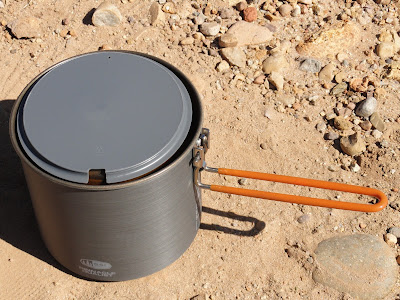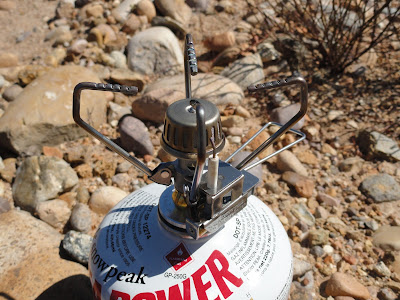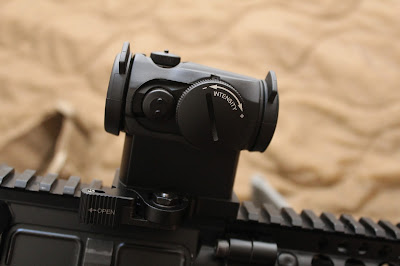I began looking for a better option. Enter the GSI Pinnacle Dualist
The cookset is made by GSI Outdoors, while the stove is made by Snow Peak. These are two completely separate companies, however the Pinnacle Dualist was designed with Snow Peak's Giga Power stove in mind. In fact, on the diagram imprinted on the side of the pot, the Giga Power is shown as an example of a stove that is packable inside the pot.
The entire system is contained in one tight package.
The included black nylon cookset pouch serves double duty as a "sink.". While I wouldn't
want food particles or greasy residue inside the pouch from using it
as a sink, I can see myself using it as an improvised general water
container. As you can see, the seams of the sack are welded and the
interior of the sack has a rubberized feel to it.
The handle of the pot is permanently attached, no detachable or flimsy
pot handles here. The handle locks in both the open and closed position,
and can be released by squeezing the sides of the handle together. The
handle is nice and sturdy when opened, and keeps the entire system together when
closed. Here's a closer view of how the handle attaches to the pot.
The lid of the pot is transparent which gives you the ability to see if your water is boiling without lifting the lid and allowing heat to escape. The lid also has holes allowing you to use it as a strainer, a NICE TOUCH for making Ramen noodles. The handle of the lid is a simple fold-down tab.
The entire cookset and stove nests neatly inside the pot.
One of my initial concerns with this system was noise. With each component nestled within itself, I believed that there was a strong possibility of rattling. Surprisingly, everything is packed so tightly together that it makes zero noise inside my pack. On today's hike, I ran for approximately a quarter mile hoping to find out just how noisy the system would be. I honestly didn't hear anything.
The Pinnacle Dualist comes with two collapsible sporks, or "foons" as GSI calls them. Opening and closing the foon is accomplished by simply sliding the foon down the handle.
The Pinnacle Dualist comes with two bowls and two insulated mugs, with the mugs storing inside the bowls. One set is orange while the other is blue, a nice touch for two people that may be sharing the system. Inside each mug and bowl are measurement markings, handy for cooking.
The mugs are insulated with a neoprene type material which keeps your beverages hot for quite a while. Each mug also has a detachable sippy lid.
The Pinnacle Dualist provides a storage pouch for your stove in order to keep it from rattling around or getting damaged.
The Giga Power is much like any typical canister stove but is exceptionally small and light. Setting up the stove is a simple process of threading it onto a fuel canister.
The Snow Peak windscreen is a separate accessory. The windscreen increases the performance of the stove and decreases boil time. In order to mount the windscreen you have to partially open the stove support legs and slide the windscreen over them. Once mounted and you fully open the stove legs, they secure the windscreen down solidly.
The particular model of stove that I purchased features the Piezo automatic ignitor. One simple click of the gray push button ignites the stove.
On the lunch menu today was Ramen noodles, requiring two cups of boiling water. The Giga Power managed to bring two cups of water to a rolling boil in 3:46 minutes, in high winds.
The collapsible foons are sturdy enough to use for stirring while cooking, a concern from many reviews on REI and Trail Space.
Strainer lid in action, straining the broth from the noodles.
A bowl of noodles and a mug of chicken broth in less than five minutes in the field. Future menus may include a bowl of instant oatmeal and a mug of coffee.
The beauty of this system is that it provides a utensil, bowl, and insulated mug for two people. If you needed to, you could use the mugs as bowls, allowing you to serve for four people! In the event that I go out alone, I can leave half the system at home in order to make more room for spices, food, etc.
When you look at the entire system and all that it includes, it surprises you that it fits in the pot.






















































